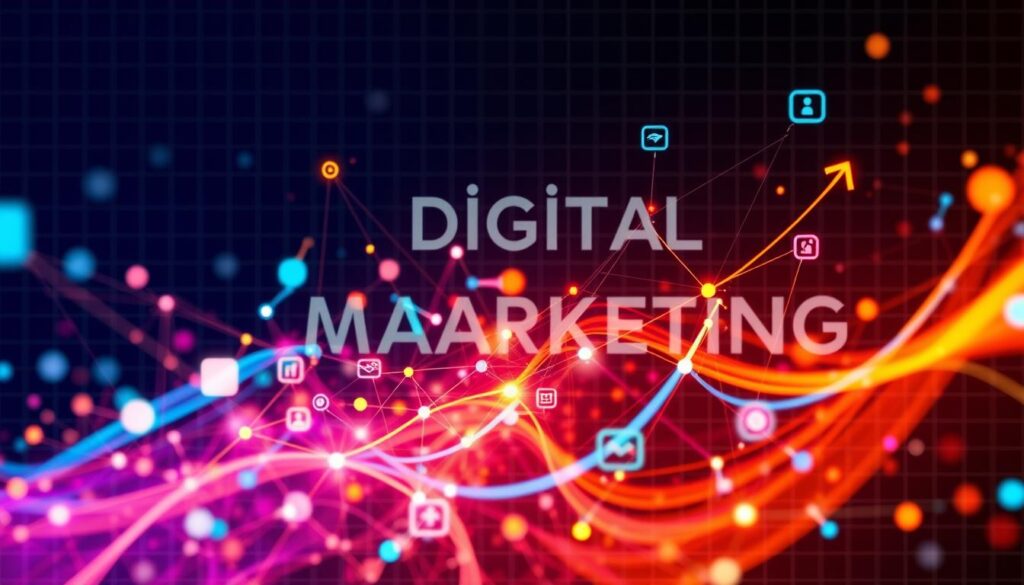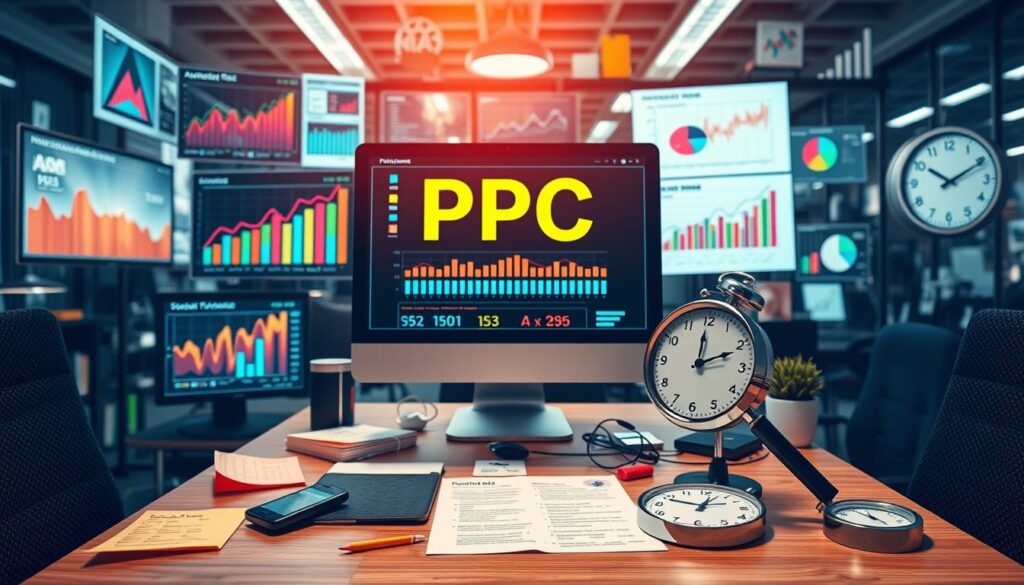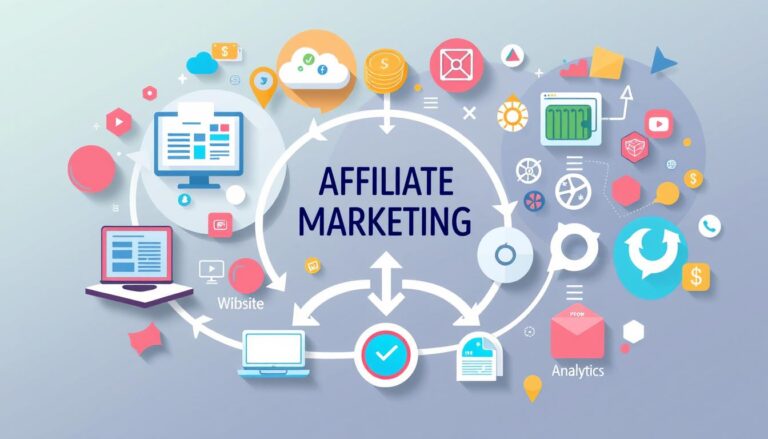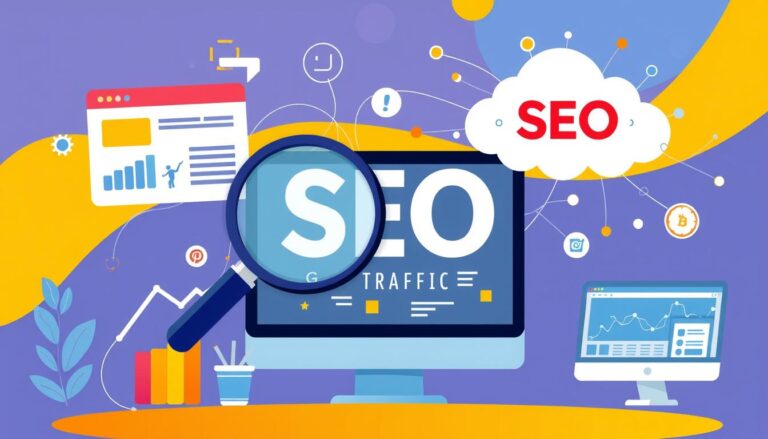Boost Your Online Advertising Strategies
Digital marketing has changed how businesses reach their audience. Online ads are key for companies wanting to stand out. Your digital marketing plan can make or break your brand’s success.
The world of online ads is always changing. New ways to reach customers keep coming up. From social media to search engine marketing, there are many ways to advertise.
Whether you’re new or well-established, knowing digital marketing can change your game. This guide will show you top online ad strategies. They can help you get the most out of your marketing.
Table of Contents
Understanding Digital Marketing Fundamentals

Digital marketing has changed how businesses reach their audience. Steve Geibel, with over 30 years of experience, says knowing your audience is key to success.
Defining Your Marketing Goals and Objectives
Creating effective marketing goals needs a strategic plan. Your digital marketing strategy should match your business goals by:
- Identifying clear, measurable outcomes
- Setting specific target metrics
- Creating actionable and time-bound objectives
Difference Between Strategy and Tactics
It’s important to know the difference between digital marketing strategy and tactics. Strategy is your overall plan, while tactics are the specific steps to reach those goals.
| Digital Marketing Strategy | Marketing Tactics |
|---|---|
| Long-term planning | Specific implementation actions |
| Big-picture approach | Detailed executable steps |
| Holistic business objectives | Targeted channel-specific actions |
Building Strong Digital Foundations
Creating strong digital foundations involves several key elements:
- Deep audience understanding
- Comprehensive content planning
- User experience optimization
- Data-driven decision making
AI has revolutionized digital marketing, with 76% of companies using it for content creation and market analysis.
By focusing on these basics, you’ll build a strong digital marketing strategy. It will drive real results and connect with your audience well.
The Power of Pay-Per-Click Advertising
Digital marketing has changed how businesses find customers, with pay-per-click (PPC) ads leading the way. This method lets you reach people when they’re looking for what you offer.

PPC ads are great for all kinds of businesses. You only pay when someone clicks on your ad. This makes it a smart choice for marketing.
Let’s look at how to make the most of your PPC ads:
Mastering Keyword Research and Bidding
Good PPC ads start with smart keyword research. You want to find words people use to find your products or services. Here are some steps to follow:
- Analyze search volume and competition for keywords
- Use long-tail keywords for more targeted reach
- Match keywords to user search intent
- Regularly update your keyword strategy
“Effective keyword research is the foundation of any successful PPC campaign.” – Digital Marketing Expert
Optimizing Ad Placements and Budget
Choosing the right ad spots can really boost your results. Sites like Google Ads, Facebook, and YouTube are great for targeted ads. Spread your budget across platforms that fit your audience’s likes.
Tracking PPC Campaign Performance
Keeping an eye on your ads is key to success. Use analytics to watch:
- Click-through rates
- Conversion rates
- Cost per acquisition
- Return on ad spend
Pro tip: Always tweak your ads based on what the data shows to get the best results.
Content Marketing Excellence
In today’s digital world, content marketing is key for businesses wanting to grow their brand and engage with their audience. It’s not just about posting random content. It’s about sharing valuable, relevant information that speaks to your audience.
The world of content marketing is changing fast. New trends are popping up:
- AI-powered content creation and optimization
- More focus on video and interactive content
- Personalized, emotionally connected storytelling
- Modular content strategies for efficient production
“Content marketing is no longer about what you sell, but about the stories you tell.” – Unknown
By 2025, quality will matter more than quantity in content marketing. Marketers will aim to create content that truly connects with people. AI will help make messages more personal and analyze how well content works.
Here are some strategies for success in content marketing:
- Develop comprehensive content pillars
- Use AI tools for content creation and optimization
- Create emotionally resonant, human-centered content
- Implement a robust content calendar
Your content strategy should aim to build real connections. The goal is not just to attract visitors, but to create meaningful interactions that transform casual readers into loyal brand advocates.
Leveraging Social Commerce Platforms
Social commerce has changed online shopping. Now, social media sites are big e-commerce places. By 2024, 30% of online shoppers will buy through social commerce. This is a huge chance for digital businesses.
Your digital plan must include strong social commerce. The global market will hit 1.25 trillion in revenue. Facebook Catalog and Instagram Shopping are leading this change.
Facebook Catalog Integration
Facebook Catalog lets businesses show off products. To succeed, focus on:
- Upload high-quality product images
- Maintain accurate product descriptions
- Update inventory in real-time
- Create dynamic product ads
Instagram Shopping Features
Instagram Shopping is great for visual marketing. It’s especially good with younger people. Businesses can:
- Tag products directly in posts
- Create shoppable stories
- Design curated product collections
- Use influencer collaborations
Social Media Product Feed Optimization
Optimizing product feeds needs a smart plan. Focus on:
- Comprehensive product attributes
- SEO-friendly descriptions
- Competitive pricing information
- Mobile-friendly presentation
“Social commerce isn’t just selling—it’s creating an immersive shopping experience that connects brands directly with consumers.”
By using these strategies, you’ll turn social platforms into sales powerhouses. This will boost growth and customer interest.
Online Advertising Strategies for Maximum Impact
Digital ad campaigns are key to modern marketing success. Your return on investment (ROI) depends on smart strategies. These use advanced targeting and optimization.
“Successful online advertising is about precision, not just presence.”
To create strong targeted marketing, you need to know a few important things:
- Use data analytics for exact audience targeting
- Make ad content visually appealing
- Advertise across different platforms
- Use AI for ad optimization
Programmatic advertising has changed digital marketing. It automates ad placement and targeting. AI and machine learning help optimize ads in real-time. This boosts engagement and conversion.
Here are some ways to increase your ad impact:
- Dynamic product categorization
- Improve product descriptions
- Use multi-attribute product feeds
- Optimize images automatically
Today, advertisers can use many channels to reach different people. Social media, search engines, and display networks are great for targeting and engaging.
Focus on important metrics like click-through rates and conversions. This helps you improve your ads and get amazing results.
Influencer Marketing Partnerships
Influencer marketing has changed digital ads by linking brands with real people through social media stars. It helps create strong partnerships that build true connections and show real results.
Getting into influencer marketing needs smart planning and picking the right social media stars. They should match your brand’s goals.
Selecting the Right Influencers
Not every influencer is right for your brand. Focus on quality over quantity. Look at these important points:
- Do their followers match your target audience?
- Is their engagement better than their number of followers?
- Is their content real and fits your brand?
- Do they know a lot about their niche and stay up-to-date?
Creating Authentic Collaborations
Good influencer marketing is about real connections. Personalized outreach and clear talks are essential for strong partnerships.
“82% of consumers are very likely to follow a micro-influencer’s recommendation”
Measuring Influencer Campaign Metrics
| Metric Category | Key Performance Indicators |
|---|---|
| Engagement | Likes, comments, shares |
| Conversion | Sales, sign-ups, website traffic |
| Brand Awareness | Reach, impressions, sentiment |
| ROI | Revenue generated per campaign dollar |
By watching your campaign’s numbers, you can make your influencer marketing better. It can bring in almost $6 for every $1 spent. This makes influencer partnerships a great chance for digital marketing wins.
Advanced Targeting and Retargeting Techniques
Digital marketers are finding new ways to reach potential customers. They use advanced audience targeting and retargeting campaigns. It’s all about understanding how users behave to create ads that really speak to them.
Retargeting is a big deal for businesses wanting to bring back website visitors. Did you know that 97% of first-time website visitors leave without buying? This shows how crucial smart retargeting strategies are.
The marketing rule of seven suggests that customer interaction at least seven times significantly increases the likelihood of gaining trust and business.
Key Targeting Strategies
- Build custom audience profiles based on:
- Customer demographics
- Geographic locations
- Preferred marketing channels
- Specific pain points
- Utilize multiple platforms for comprehensive reach
- Create unique campaigns for different audience segments
Retargeting Platform Insights
| Platform | Unique Targeting Feature | Engagement Potential |
|---|---|---|
| Facebook Ads | Detailed user interest targeting | High |
| Visual product remarketing | Medium-High | |
| Google Analytics | Behavior-based tracking | High |
Effective customer segmentation leads to personalized ads. By tracking user interactions, you can tailor your retargeting campaigns. This way, you meet individual customer needs directly.
Smart marketers keep improving their strategies. They use A/B testing, pixel tracking, and adjust campaigns for better results. These efforts ensure they get the most out of their marketing and connect better with their audience.
Data Analytics and Performance Tracking
Digital marketing success depends on using marketing analytics. Knowing how to track and analyze data helps make your marketing strategies better. It turns guesswork into smart, data-driven choices.
Today’s marketers use advanced data analysis to find useful insights. By setting up strong Key Performance Indicators (KPIs), you can see how well your marketing works. This lets you make more accurate decisions.
Key Performance Indicators (KPIs) That Matter
- Conversion Rate = (Number of Conversions / Total Visitors) * 100
- Bounce Rate – measuring user engagement
- Click-Through Rate (CTR)
- Engagement Rate across digital platforms
Analytics Tools and Platforms
Tools like Google Analytics 4 (GA4), SEMrush, and Google Data Studio give deep insights into your marketing. They help you:
- Track user behavior
- Analyze campaign effectiveness
- Optimize marketing strategies
Data-Driven Decision Making
“Without data, you’re just another person with an opinion.” – W. Edwards Deming
Use SMART goals to improve your marketing analytics. By breaking down data by demographics, interests, and behaviors, you can target your marketing better. This way, your campaigns speak directly to your audience.
A/B testing and predictive analytics help forecast trends and improve your marketing. Remember, data is your guide in digital marketing.
Geofencing and Location-Based Marketing
Location-based advertising has changed mobile marketing a lot. It lets businesses reach customers with great accuracy. Geofencing technology creates virtual boundaries. This changes how brands connect with people in specific areas.
Geofencing uses GPS, Wi-Fi, and Bluetooth to track devices in certain areas. It’s a new way to hyper-target local targeting. This means marketing messages are sent at the right time and place.
“Location is the new cookie” – Marketing experts say geographically precise ads are powerful.
Geofencing marketing has many benefits:
- It boosts local foot traffic
- Increases sales conversions
- Delivers personalized customer experiences
- Maximizes marketing cost-effectiveness
For a successful geofencing campaign, businesses need a good plan. They should:
- Study their target audience’s behavior
- Set up clear, specific geographic areas
- Create clear, direct messages
- Use different targeting methods
Marketers using geofencing see big engagement boosts. Some see up to 32% more “Buy Now” clicks near key locations. This method is better than old cookie-based marketing. It gives real insights into customer behavior and what they want.
Marketplace Optimization for E-commerce
Online selling is a competitive world. Amazon is a key platform, with 50% of searches starting there. How you manage your marketplace can greatly affect your sales.
For better online selling, you need several key strategies. These can really improve your performance:
Amazon Advertising Strategies
Amazon’s ads can help your products stand out. You can use targeted ads to find the right customers. Important strategies include:
- Sponsored Product Ads
- Headline Search Ads
- Product Display Ads
Product Feed Management
Good product listings are vital for success. You need to manage your product feeds well. This means:
- Keeping product info consistent
- Using high-quality images
- Writing detailed descriptions
Pricing Optimization
Dynamic pricing can change the game for sellers. Tools for automated repricing help keep prices competitive and profits high.
| Pricing Strategy | Potential Impact |
|---|---|
| Competitive Pricing | Increases visibility and sales |
| Dynamic Repricing | Maximizes profit margins |
| Volume-Based Discounts | Encourages larger purchases |
Marketplace success is about strategic approach, not just product listing.
By using these strategies, you can boost your marketplace performance. E-commerce optimization is an ongoing process of refinement and adaptation.
Mobile Advertising Innovations
Mobile advertising has changed the game in digital marketing. It’s now key for businesses aiming at today’s smartphone users. With over 54% of internet traffic coming from mobiles, focusing on mobile is crucial for brands.
The mobile ad world opens up new chances for app and in-app ads. Companies can use new ways to reach people on their most personal device.
- Location-based marketing uses GPS to send ads right to users.
- Push notifications let brands talk to customers in real-time.
- Custom mobile experiences boost sales.
“Mobile is not just a channel, it’s the primary platform for consumer interaction in the digital age.” – Digital Marketing Expert
New mobile ad methods include:
- Contextual targeting based on how users act.
- Interactive ads that make the user experience better.
- AI for making ads more personal.
By going mobile-first, companies can make ads that are engaging and not too pushy. This works well with today’s young people who spend over six hours a day on their phones.
Conclusion
Digital marketing trends are changing the game for advertisers. The global ad market is expected to hit $786.2 billion by 2026. This opens up big chances for businesses ready to try new marketing moves in 2024.
Your ad strategies need to use the latest tech and data. Mobile ads are on the rise, thanks to tools like Google Ads and Facebook Ads Manager. Content marketing and teaming up with influencers are key to reaching people in a real way.
To succeed in 2024, you must get the hang of new digital channels. This means using social media ads and precise targeting. Tools like SEMRush and HubSpot can help you see how well your ads are doing and make them better.
Your main aim is to make connections that go beyond just ads. Use data, mobile-friendly designs, and genuine content to grab your audience’s attention. This way, you can make marketing that truly connects with people in today’s digital world.







